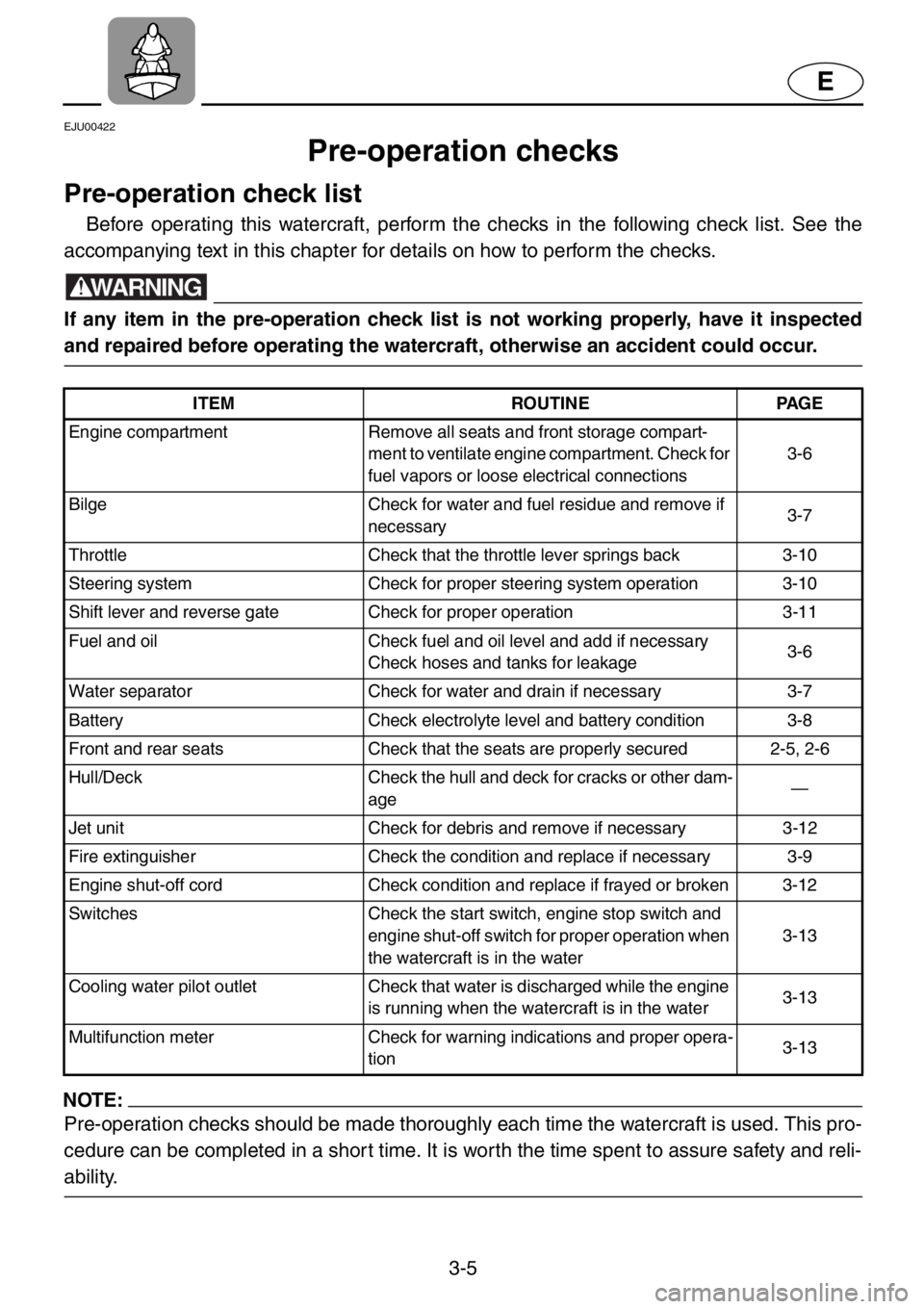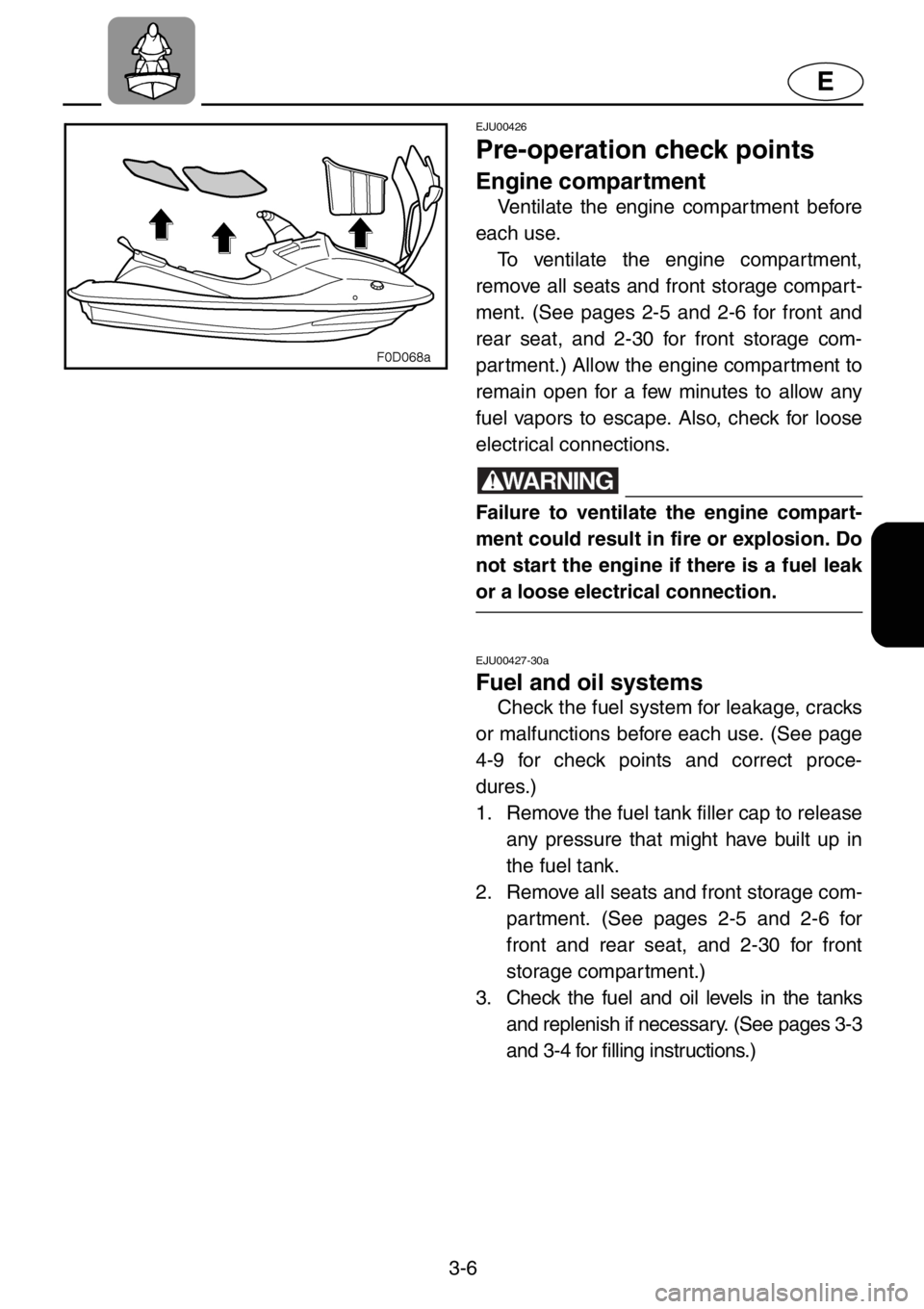Page 45 of 131

2-20
E
EJU00698b
Multifunction meter
This meter contains following functions for
help and convenience in operating the
watercraft.
1
“MODE” button
2
“SET” button
3
“CODE” setting buttons
4
Tachometer
5
Speedometer
6
Fuel meter
7
Engine oil meter
8
Display for Clock, Hour meter, Trip meter and
Trip timer
9
Warning light
0
Display for PADLOC and direction of warning
indicator
A
Battery warning indicator
B
Engine overheat warning indicator
C
Fuel warning indicator
D
Oil warning indicator
CAUTION:
●Do not run the engine at full throttle or
more than 15 seconds to check the
meter for operation on land. The
engine could overheat.
●Use the specified resistor-type spark
plugs and caps, otherwise the meter
may function erratically.
NOTE:
The demonstration mode display starts
showing after the engine starts. Then all dis-
plays light up and the buzzer sounds twice.
The meter will operate normally after a few
seconds. The current display will continue to
operate for 30 seconds after the engine
stops.
Page 50 of 131
2-25
E
EJU00387a
Engine oil meter
The engine oil meter is provided for con-
venient oil level checking while operating the
watercraft.
The engine oil meter has 3 segments
which show the amount of oil remaining in
the oil tank.
NOTE:
The indication of the segments differs
depending on your operating condition. Use
the meter as a reference.
EJU00388aa
Clock
A 12-hour clock is provided in this meter.
To show the clock, press the “MODE” but-
ton until the display shows “CLOCK” while
the engine is running.
1. When the display shows “CLOCK,” press
the mode button for at least 3 seconds.
2. The buzzer will sound once. The hour
display and “SET” start blinking. Then
press the “A/SET” button until the
desired hour is displayed.
3. Press the “MODE” button again.
4. The buzzer will sound once. The minute
display and “SET” start blinking. Then
press the “A/SET” button until the
desired minute is displayed.
5. Press the “MODE” button again.
Page 53 of 131

2-28
E
EJU00717a
Oil warning indicator
If the oil remaining in the tank drops to
about 1.4 L (0.37 US gal, 0.31 Imp gal) or
the oil filter is clogged, the lowest oil level
segment, the oil warning indicator, “OIL” and
the warning light begin to blink. The buzzer
also starts sounding intermittently.
If the oil warning indicator begins to blink,
refill with engine oil as soon as possible.
NOTE:
If the warning indicator blinks with adequate
oil in the tank, check the oil filter for clog-
ging.
EJU00718a
Engine overheat warning
indicator
If the engine starts to overheat, the engine
overheat warning indicator, “W.TEMP” and
the warning light begin to blink. The buzzer
also starts sounding intermittently.
If the engine continues to be operated at
higher speed after the warning system indi-
cators have come on intermittently, the warn-
ing indicator, “W.TEMP” and the warning
light will change to being on continuously.
Also, the engine will stop and the buzzer will
sound continuously. Refer to “Engine over-
heat warning system” on page 2-17.
NOTE:
When the warnings overlap each other, their
priority is as follows.
1. Final overheat
2. Initial overheat
3. Oil
4. Fuel
5. Battery
Page 57 of 131

E
3
EJU00410
OPERATION
Fuel and oil................................................ 3-1
Gasoline .................................................. 3-1
Filling the fuel tank .................................. 3-3
2-stroke engine oil................................... 3-3
Filling the oil tank .................................... 3-4
Pre-operation checks............................... 3-5
Pre-operation check list .......................... 3-5
Pre-operation check points..................... 3-6
Operation................................................. 3-14
Engine break-in ..................................... 3-14
Launching the watercraft ...................... 3-16
Starting the engine................................ 3-16
Stopping the engine.............................. 3-19
Leaving the watercraft .......................... 3-19
Operating your watercraft..................... 3-20
Getting to know your watercraft............ 3-20
Learning to operate your watercraft ..... 3-20
Riding watercraft with passengers ....... 3-21
Starting the watercraft........................... 3-22
Boarding and starting in deep water .... 3-24
Capsized watercraft .............................. 3-26
Turning the watercraft........................... 3-28
Stopping the watercraft......................... 3-30
Beaching the watercraft ........................ 3-31
Docking the watercraft .......................... 3-31
Reverse on waterways ......................... 3-32
Rough water operation ......................... 3-32
Post-operation checks.......................... 3-33
Transporting........................................... 3-35
Page 60 of 131
3-3
E
EJU00724a
Filling the fuel tank
CAUTION:
Be careful when refueling. Avoid getting
water or other contaminants in the fuel
tank. Contaminated fuel can cause poor
running or engine damage.
1. Open the hood and remove the front
storage compartment, to check the fuel
level. (See page 2-30 for front storage
compartment.)
2. Open the fuel tank filler cap, and slowly
add fuel to the fuel tank.
3. Stop filling when the fuel just reaches the
top of the fuel tank visible under the
engine oil tank.
EJU00324a
2-stroke engine oil
If YAMALUBE 2-W is not available,
another 2-stroke engine oil with an NMMA-
certified TC-W3 rating may be used.Fuel tank capacity:
Total: 70 L (18.5 US gal, 15.5 Imp gal)
Reserve: 12 L (3.2 US gal, 2.7 Imp gal)
Recommended engine oil:
YAMALUBE 2-W
Page 62 of 131

3-5
E
EJU00422
Pre-operation checks
Pre-operation check list
Before operating this watercraft, perform the checks in the following check list. See the
accompanying text in this chapter for details on how to perform the checks.
WARNING
If any item in the pre-operation check list is not working properly, have it inspected
and repaired before operating the watercraft, otherwise an accident could occur.
NOTE:
Pre-operation checks should be made thoroughly each time the watercraft is used. This pro-
cedure can be completed in a short time. It is worth the time spent to assure safety and reli-
ability.
ITEM ROUTINE PAGE
Engine compartment Remove all seats and front storage compart-
ment to ventilate engine compartment. Check for
fuel vapors or loose electrical connections3-6
Bilge Check for water and fuel residue and remove if
necessary3-7
Throttle Check that the throttle lever springs back 3-10
Steering system Check for proper steering system operation 3-10
Shift lever and reverse gate Check for proper operation 3-11
Fuel and oil Check fuel and oil level and add if necessary
Check hoses and tanks for leakage3-6
Water separator Check for water and drain if necessary 3-7
Battery Check electrolyte level and battery condition 3-8
Front and rear seats Check that the seats are properly secured 2-5, 2-6
Hull/Deck Check the hull and deck for cracks or other dam-
age—
Jet unit Check for debris and remove if necessary 3-12
Fire extinguisher Check the condition and replace if necessary 3-9
Engine shut-off cord Check condition and replace if frayed or broken 3-12
Switches Check the start switch, engine stop switch and
engine shut-off switch for proper operation when
the watercraft is in the water3-13
Cooling water pilot outlet Check that water is discharged while the engine
is running when the watercraft is in the water3-13
Multifunction meter Check for warning indications and proper opera-
tion3-13
Page 63 of 131

3-6
E
EJU00426
Pre-operation check points
Engine compartment
Ventilate the engine compar tment before
each use.
To ventilate the engine compartment,
remove all seats and front storage compart-
ment. (See pages 2-5 and 2-6 for front and
rear seat, and 2-30 for front storage com-
partment.) Allow the engine compartment to
remain open for a few minutes to allow any
fuel vapors to escape. Also, check for loose
electrical connections.
WARNING
Failure to ventilate the engine compart-
ment could result in fire or explosion. Do
not start the engine if there is a fuel leak
or a loose electrical connection.
EJU00427-30a
Fuel and oil systems
Check the fuel system for leakage, cracks
or malfunctions before each use. (See page
4-9 for check points and correct proce-
dures.)
1. Remove the fuel tank filler cap to release
any pressure that might have built up in
the fuel tank.
2. Remove all seats and front storage com-
partment. (See pages 2-5 and 2-6 for
front and rear seat, and 2-30 for front
storage compartment.)
3. Check the fuel and oil levels in the tanks
and replenish if necessary. (See pages 3-3
and 3-4 for filling instructions.)
Page 101 of 131

4-8
E
EJU00536
Periodic maintenance chart
The following chart gives general guidelines for periodic maintenance. However, depend-
ing on your operating conditions maintenance may need to be performed more frequently.
(
●) This mark indicates maintenance that you may do yourself.
(
❍) This mark indicates work to be done by a Yamaha dealer.
*1: Grease capacity: 33.0–35.0 cm3 (1.11–1.18 oz)
*2: Grease capacity: 6.0–8.0 cm3 (0.20–0.27 oz)
MAINTENANCE INTERVAL INITIALTHEREAFTER
EVERYPA G E
10
hours50
hours100
hours100
hours200
hours
ITEM
3
months6
months6
months12
months
Spark plug Inspect, clean, adjust●●●●
4-14
Lubrication points Lubricate●●
4-15
Intermediate housing Lubricate❍
*1●
*2●
*2 4-18
Fuel system Inspect❍❍
4-9
Fuel filter Check, replace❍❍
4-10
Fuel tank Clean❍
4-10
Oil injection system Inspect, clean❍❍
4-11
Trolling speed Adjust●●
4-21
Carburetor throttle shaft Inspect❍❍
—
Cooling water passages Flush
●
(after
ever y
use)4-1
Bilge strainer Clean●●●
—
Impeller Inspect●●●
—
Steering cable Inspect●●
4-12
Steering master Inspect❍❍❍
—
QSTS mechanism Inspect●●
4-13
Shift cable and mechanism Inspect, adjust●●
4-12
Throttle cable Inspect, adjust●●
4-12
Choke cable Inspect, adjust●●
4-18
Stern drain plugs Inspect, replace●
3-7
Battery Inspect
●(inspect
fluid level
before
ever y
use)
4-19
Rubber coupling Inspect❍
—
Nuts and bolts Retighten❍❍❍
—